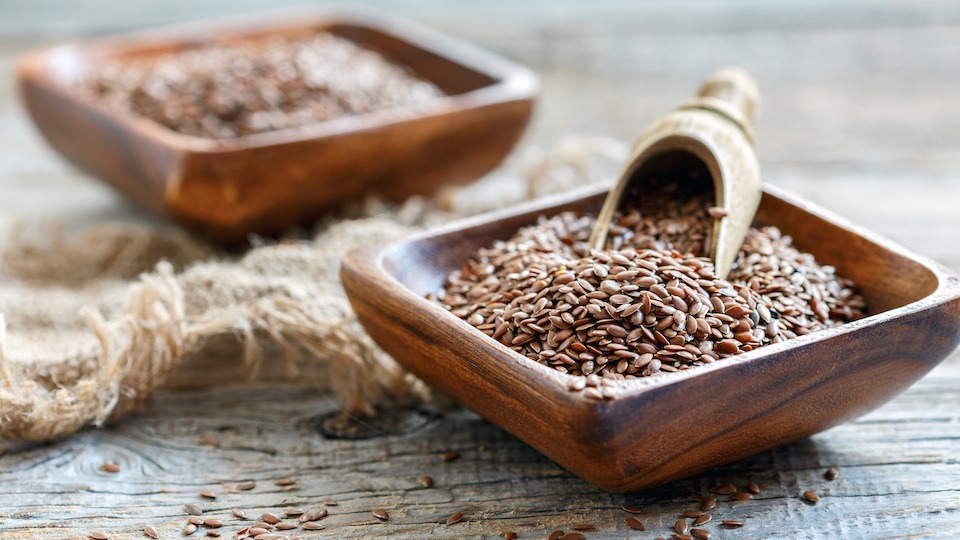One of our favorite family stories came courtesy of my middle daughter (now a teenager) when she was just a toddler. We were visiting family on vacation, and my aunt wanted to give her a little mid-day snack of some yogurt and fresh fruit. When the bowl of yogurt was presented to her…she looked at it and then asked with her classic toddler lisp, “Can I please have flax?” My aunt looked at us terribly confused…she had no idea what my daughter meant. In fact, she had no idea what “flax” even was. We explained that when we give the kids yogurt, we often added a few spoonfuls of ground flaxseed to bump up the fiber and add some omega-3 oils to their diets. Our kids all learned to like the addition so that the yogurt seemed like it was missing something without it. This article by my team at UpWellness explains many reasons why you should consider adding flax to your diet and a list of easy ways to do just that. Enjoy,
-JL
Don’t be fooled by their unassuming package…flaxseeds pack a serious nutrient punch and provide many health benefits in just a few tablespoons. These super-seeds are also incredibly delicious, and it is easy to incorporate them in any diet. Here are our favorite reasons to eat more flaxseeds and a few simple ways to sneak them into your meals.
Benefits of flaxseed
Can aid digestive health
Flaxseed is an excellent source of soluble and insoluble dietary fiber and can support digestive health and promote healthy bowel movements. Soluble fiber can help slow down digestion rates, while insoluble fiber can help prevent constipation and improve irritable bowel syndrome.
Protect against cancer growth
One study of 161 men showed that flaxseed could help slow or stop the rate of prostate cancer progression. Researchers believe this is due to the high content of omega-3 fatty acids that can disrupt the growth of existing cancer cells and protect from cancer development.
Lower cholesterol and improve heart health
As we’ve established, flaxseeds are loaded with nutrients including, fiber, phytosterols, and omega-3 fatty acids. All of which contribute to heart health and help prevent cardiovascular disease. Phytosterols are particularly beneficial molecules because they help prevent the absorption of bad cholesterol into the intestine.
How to eat more flaxseed:
It is not nearly as hard as you may think to incorporate flaxseeds into your daily diet. These easy and delicious tips will help you get the recommended dose of about 1-2 tablespoons of flaxseed per day. Remember to grind flaxseeds before using to increase nutrient access and always store in the refrigerator once ground.
- Sprinkle over your oatmeal
- Add flaxseed to salad dressings or incorporate into your salad
- Blend into smoothies and juices of any flavor
- Add to greek yogurt along with fruit for a filling breakfast
- Stir into soups to help make them creamy and filling
- Add to homemade granola
- If you’re ever out of eggs or want a vegan egg substitute, simply mix 1 tablespoon of ground flaxseeds and 3 tablespoons of cold water together and let sit for a few minutes before using.
- Use instead of flour. Though some baking recipes won’t reach the correct consistency without flour, ground flaxseed is an excellent, gluten-free substitution for most flour in cooking.
Flaxseed butter
Healthier than peanut butter, this delicious spread will fill your craving for that creamy texture. Enjoy this on a piece of Ezekiel bread or coconut flour pancakes. You can even add a dollop to smoothies or stir a spoonful into your soup.
Ingredients:
- ½ cup Flax Seeds
- ⅓ cup Coconut oil
- 2 Tbsp honey, optional
- 1 pinch of salt
Instructions:
- Roast flaxseeds in a large pan over medium heat, frequently tossing to ensure even toasting.
- Wait until flaxseeds are fragrant and hot to the touch.
- Remove from heat and let cool.
- Add flaxseeds to a food processor and pulse on high until a powder is formed.
- Add in salt and honey, if desired and pulse again to combine.
- Incorporate ¼ a cup of coconut oil and process until sticky and mixed.
- Add in remaining oil and pulse on high for about 3 minutes or until a smooth paste is formed. You will likely have to scrape the sides with a spatula to ensure even processing.
- Transfer to a jar with a lid and store in the fridge until ready to use.
- Let butter reach room temperature before using, as the coconut oil will harden in the fridge and make it difficult to spread.
Note: Since flaxseed is high in fiber, it can be a bit of a shock to your digestive system once you start eating it, especially, if you have been eating a fiber-deficient diet. Start with about 1-2 teaspoons per day until your stomach has time to adjust to avoid bloating, cramping, gas, or constipation. Slowly increase your intake as you begin to tolerate more fiber.
If you are one any prescription medication, it is important to talk to your doctor before beginning daily flaxseed supplementation since it could interfere with the absorption of certain drugs.
-The UpWellness Team









